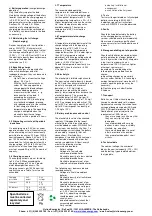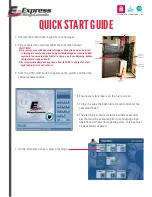
c) Battery operation
(charge/discharge
operation)
Only the battery supplies the load.
Hereby the charge voltage of the battery
towards the end of the charging process
is 2,6-2,75 V/cell. The charging process
and parameters must be monitored (see
Sections 2.4, 2.5 and 2.6). When
reaching a fully charged state the
charging process must be switched off.
The battery can be switched to the load
as necessary.
2.3 Maintaining the full charge
(float charging)
Devices complying with the stipulations
under DIN 41773 (lU characteristic)
must be used. They are to be set so that
the average cell voltage is 2,23V +/- 1%
(2,25 V +/- 1% for UPS) cell at 20°C and
the electrolyte density does not decrease
over a protracted period
(otherwise see 2.8).
2.4 Equalizing charge
Equalizing charges are required after
exhaustive discharges and after
inadequate charges; they can be carried
out as follows:
-
Up to 72 hours at constant voltage
ofmax. 2.4 V/ celI,
-
With the I or W characteristic as
under 2.6. If during equalizing
charging permitted load voltages
are exceeded, appropriate
measures must be taken, e. g.
disconnection of the load. If
exceeding the maximum
temperature of 55°C the charging
must either be stopped, proceed
with reduced current, or be switched
to float charge to allow the
temperature to drop. The equalizing
charge is completed when the
electrolyte densities no longer
increases within a period of 2 hours.
2.5 Alternating currents with periodic
deviations
On recharging up to 2,4 V/cell as under
operation modes a) to c) the actual value
of the alternating current is occasionally
permitted to reach max. 20 A per 100 Ah
nominal capacity. Above 2,4 V/cells 10 A
per 100 Ah nominal capacity may not be
exceeded. In a fully charged state with a
charge voltage of 2,23 to 2,30 V/cell the
actual value of the alternating current
must not exceed 5 A per 100 Ah nominal
capacity.
2.6 Charging currents
The charging currents are not limited up
to 2,4 V/ celI. When exceeding the
charging voltage of 2,4 V/cell, greater
water decomposition occurs. The
charging currents per 100 Ah nominal
capacity shown in Table 1 must not be
exceeded.
Charging
procedure
Cell
model
Cell
voltage
I-charact.
5,0 A
2,6
-
2,75
W-charact.
7,0 A
3,5 A
at 2,4 V
at 2,65V
2.7 Temperature
The recommended operating
temperature for Lead-acid batteries is
10°C to 30°C. The technical data apply
for the nominal temperature 20°C. The
ideal operating temperature is 20 +/- 5°C.
Higher temperatures shorten the service
life. Lower temperatures reduce the
available capacity. The maximum
temperature of 55°C must not be
exceeded.
2.8 Temperature-related charge
voltage
A temperature-related adjustment of the
charge voltage within the operating
temperature of 15°C to 25°C is not
necessary. Should the temperature
range be lower than 15°C and/or higher
than 25°C a temperature related
adjustment of the charge voltage should
be made. The temperature correction
factor is (-0.004 V/Cell per °K).
Should the temperature constantly rise
above 40°C then the factor is (-0.003
V/Celi per °K).
2.9 Electrolyte
The electrolyte is diluted sulphuric acid.
The nominal electrolyte density is based
on 20°C and the nominal electrolyte level
when fully charged with maximum
dev/ - 0.01 kg/I. Higher
temperatures reduce the electrolyte
density; lower temperatures increase the
electrolyte density. The associated
correction factor is 0.0007 kg/I per °K.
Example: electrolyte density of 1.23 kg/I
at 35°C corresponds to a density of 1.24
kg/I at 20°C or electrolyte density of 1.25
kg/I at 5°C corresponds to a density of
1.24 kg/I at 20°C.
3. Battery maintenance and control
The electrolyte level must be checked
regularly. If it dropped to the lowest
electrolyte level mark, purified water
must be added as under DIN 43530 Part
4, maximum conductivity 30
µ
S/cm. To
avoid leakage currents keep the battery
clean and dry (especially inter cell
connections). Plastic battery
components, in particular the vent caps,
must only be cleaned with water that
contains no additives. At least every 6
months the following must be
measured and recorded:
-
Battery voltage
-
Voltage of a few selected
cells/mono block batteries
-
Electrolyte density of a few selected
cells/mono block batteries
-
Electrolyte temperature of a few
selected cells/mono block batteries.
The following must be measured and
recorded annually:
-
Voltage of all cells/mono block
batteries
-
Electrolyte density of all cells/mono
block batteries
-
Electrolyte temperature of a few
selected cells/mono block batteries
-
Should the float charge voltage in
one celi deviate more than + 0.1 V
or - 0.05 V from the average value
(see 2.3), equalizing charging
should be done (see 2.4.). Annual
visual checks:
-
on bolted connectors (check that
unsecured bolt connectors are
firmly seated)
-
on battery installation or
arrangement
-
on ventilation of battery room.
4. Tests
Tests must be performed on fully charged
batteries according to EN 60896-1.
ln addition, special test instructions
such as EN 50272-2 must be observed.
5. Faults
Should faults be detected in the battery
or the charging device, customer
services should be called in immediately.
Measurement records under Section 3
are necessary for fast fault detection and
removal.
6. Storage and taking out of operation
Should cells/batteries be stored or taken
out of operation for a longer period of
time, they must be stored fully charged in
a dry, frost-free room with max.
temperature of 25°C. Direct sunlight or
other heat sources must
be avoided. To avoid damage the
following charging methods can be
chosen:
a.
Equalizing charges on a quarterly
basis as under Section 2.4. In average,
ambient temperatures of more than 30°C
monthly equalizing charges may be
necessary.
b.
Float charging as under Section
2.3.above.
7. Transport
Batteries, wet, filled with acid require
transport under demands of European
Agreement concerning the international
carriage of dangerous goods (ADR and
RID). ADR special provision No. 598:
New batteries are not subject to the
requirements of ADR, when:
-
they are secured in such a way that
they can not slip, fall or be
damaged;
-
they are provided with carrying
devices, unless they are suitably
stacked, e.g. on pallets;
-
there are no dangerous traces of
alkalis or acids on the outside;
-
they are protected against short
circuits.
8. Technical data
The nominal voltage, the number of
blocks, the nominal capacity (C10 = CN)
and the battery type are obtained from
the type plate.
Victron Energy bv / De Paal 35 / 1351 JG ALMERE / The Netherlands
Phone: (+31) (0)36 535 97 00 / Fax: (+31) (0)36 535 97 40 /
www.victronenergy.com
/ e-mail: [email protected]
Spent batteries
must be collected
separately and
recycled




















